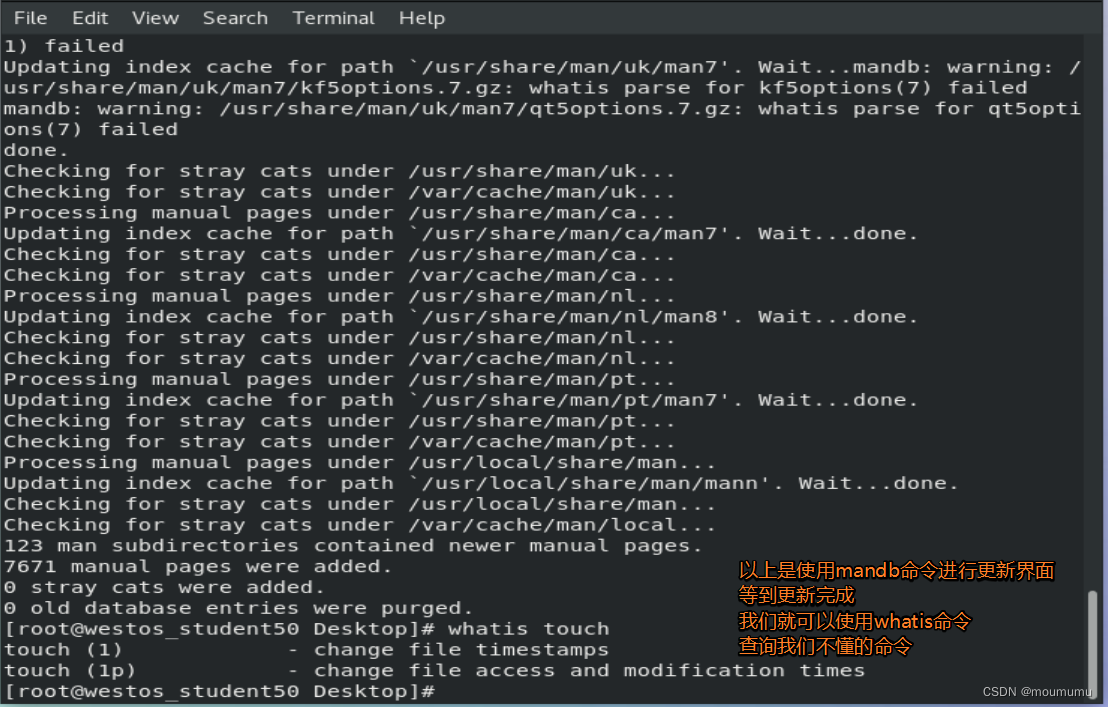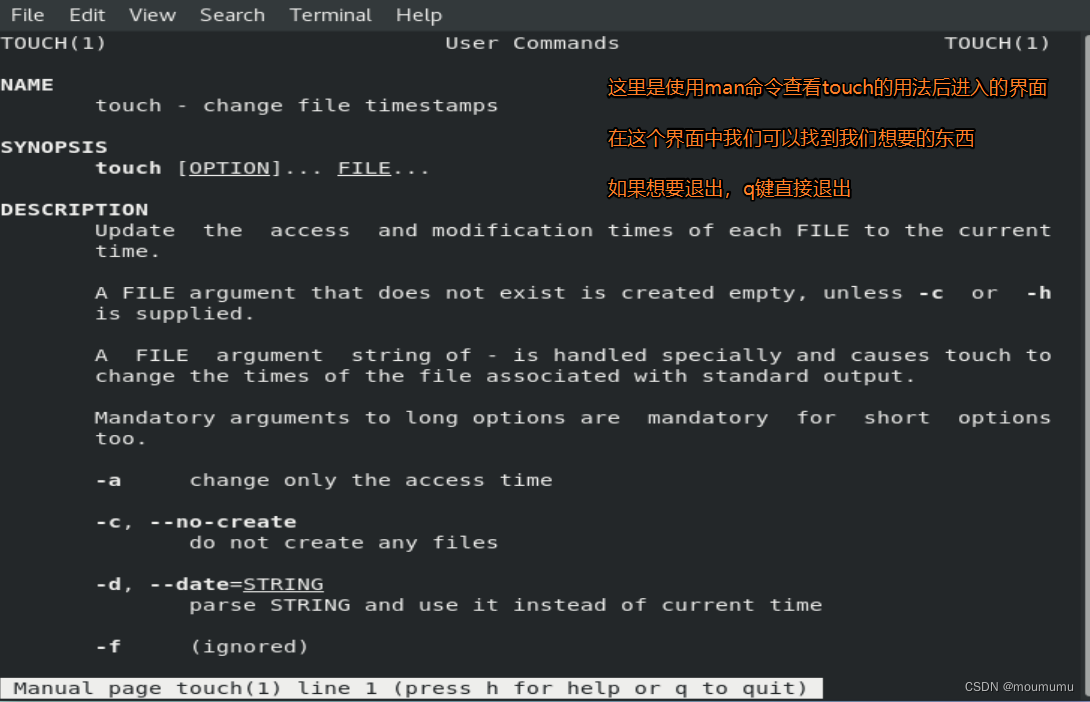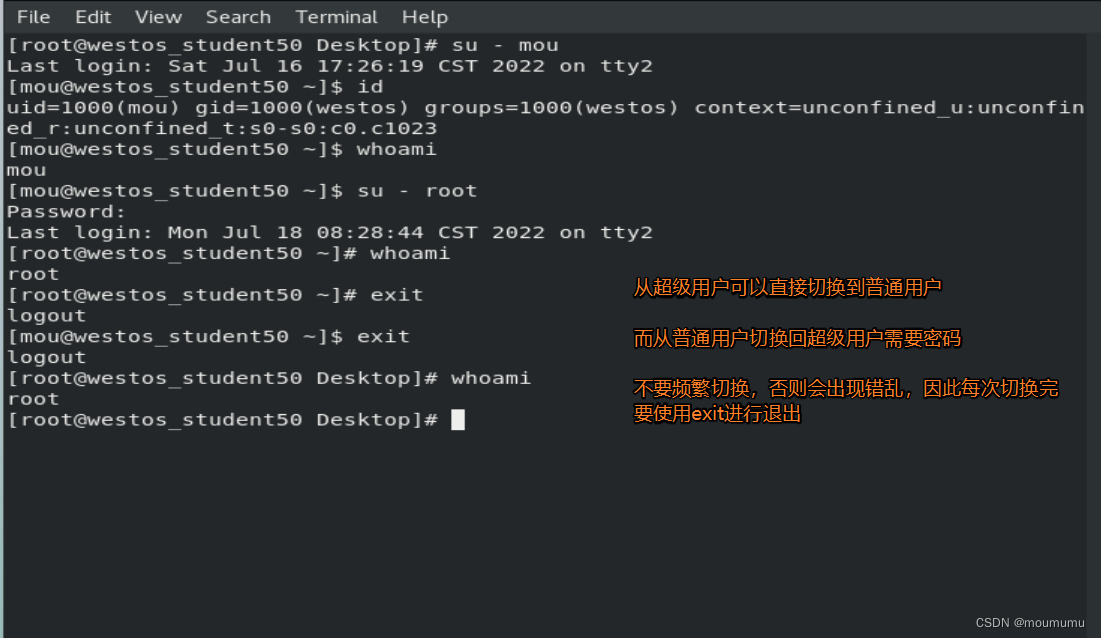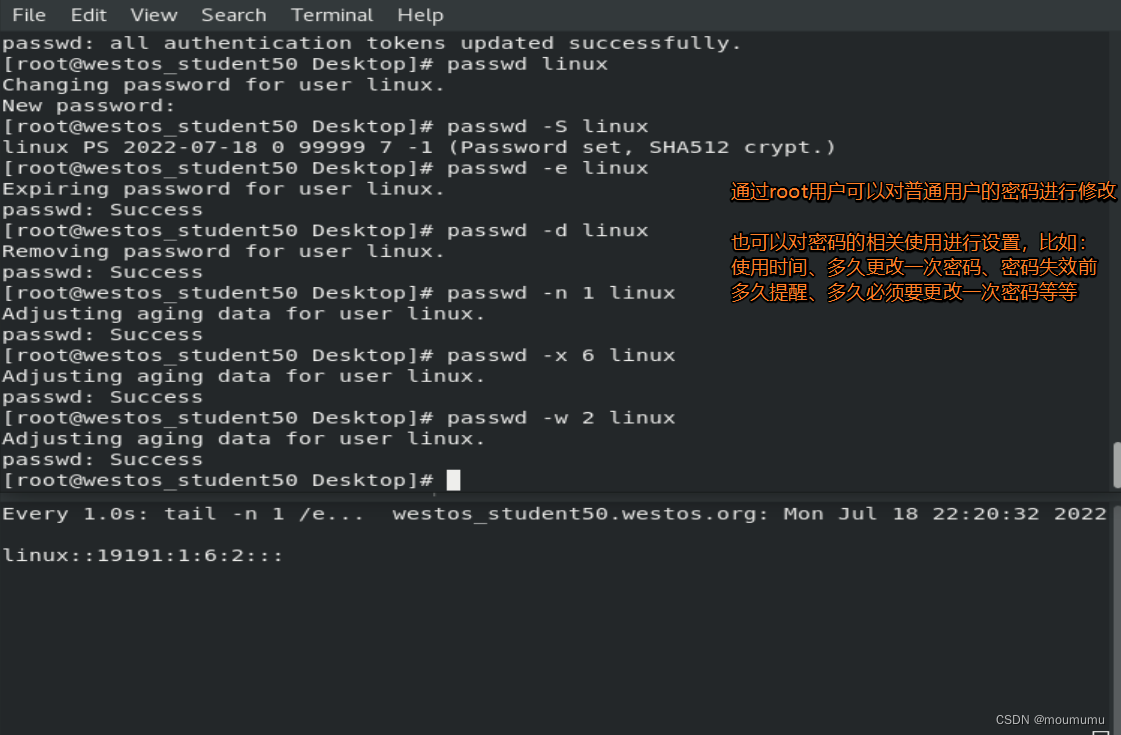文章目录
前言
这节首先会将上节课没有学完的使用命令行获得帮助结束;然后开始进行Linux系统中的用户管理,这部分将涉及用户、用户组的概念以及用户切换、用户查看等内容。
一、使用命令行获得帮助
1.whatis 命令
whatis rm ##查看命令的基本用途
##查看过程中出现
#rm: nothing appropriate.
1.表示要查看内容没有帮助
2.系统帮助数据未更新用mandb命令更新
“注意:当执行whatis命令出现 nothing appropriate 时大多数情况是因为系统的帮助数据库未更新,如何解决此问题,需要在root用户下执行mandb”


2,rm、man命令的使用
rm --help ##查看命令的基本用法
[] ##内容可加可不加
… ##内容个数任意
<> ##必须在命令执行时加入的元素
man rm ##命令用法详解 man是manual的缩写
man -k passwd ##passwd关键字有多少级别的man
##man的级别
1 命令
2 系统调用
3 函数库调用
4 特殊文件(设备文件等) #5 文件
6 游戏
7 特殊的包
8 系统管理命令
9 内核信息规则
man rm ##进入到rm命令的帮助
q ##退出
/关键字 ##搜索关键字,n 向下匹配, N 向上匹配
G ##快速移动到man的最后
g ##表示快速移动到man的最前
具体操作如下:
[root@westos_student50 Desktop]# whoami --help
Usage: whoami [OPTION]...
Print the user name associated with the current effective user ID.
Same as id -un.
--help display this help and exit
--version output version information and exit
GNU coreutils online help: <https://www.gnu.org/software/coreutils/>
Full documentation at: <https://www.gnu.org/software/coreutils/whoami>
or available locally via: info '(coreutils) whoami invocation'
[root@westos_student50 Desktop]# man touch

二、Linux系统中的用户管理
1.用户及用户组存在的意义
系统资源是有限的,如何合理分配系统资源?
在这个问题解决时必须要有资源配合
1.身份 account
2.授权 author
3.认证 auth
3A机制,3A机制组成系统中最底层的安全架构
2)用户组存在意义
用户组是一个逻辑容器
对用户进行归类和统一授权
2.用户及用户组在系统中存在的方式
电脑对数字敏感 id
人类对字符串敏感 名称
id <-------> 名称 必须要记录到文件当中用户才能存在
用户就是/etc/passwd文件中的一行字符
用户组存在的方式就是/etc/group 文件中的一行字符
3.用户切换
1)用户查看
*whomai ##查看当前用户
*id ##查看用户id信息
-u ##查看用户的用户id
-g ##查看用户主组id
-G ##查看用户所有的组的id
-n ##显示名称
用户id范围: 0-65535
0: ##Linux超级用户ID
1-999: ##Liunx系统自用ID
1000-65535: ##用户级ID
##以上ID设定规则都被记录在/etc/login.defs
[root@westos_student50 Desktop]# whoami
root
[root@westos_student50 Desktop]# id
uid=0(root) gid=0(root) groups=0(root) context=unconfined_u:unconfined_r:unconfined_t:s0-s0:c0.c1023
[root@westos_student50 Desktop]#
2)用户切换
su - username #切换用户环境
从超级用户切换到普通用户不需要密码
而从普通用户切换到超级用户或者普通用户都需要密码
##注意:在做用户切换时当使用完毕用户身份及时退出
#不要在一个shell中反复执行su命令
#在一个shell中反复执行su命令会导致环境错乱

4.用户涉及到的配置文件
/etc/passwd ##用户身份信息文件
#用户名称:用户密码:用户id:用户主组id:用户说明:用户家目录:用户默认shell
/etc/group ##组身份信息文件
#组名称:组密码:组id:组的附加成员
/etc/skel/.* ##用户环境配置文件模板
/etc/shadow ##用户认证信息文件
/home/username ##用户家目录
/var/spool/mail/username ##用户邮箱文件
5.用户和用户组的建立和删除
watch -n 1 “tail -n 4 /etc/passwd /etc/group;echo =======;ls -l /home”
useradd username ##用户建立
-u id username ##uid 2**16=0-65535
##0 表示超级用户
##1-200 系统预留id
##201-999 系统用户
##1000-60000 用户级用户
##/etc/login.defs 记录用户建立的默认规则
-g id username ##主组id
-G id username ##附加组id
-d dir username ##指定用户家目录
-M username ##建立用户时不建立家目录
-c word username ##指定用户说明
-s shell username ##指定用shell
userdel -r username ##用户删除 -r 删除用户的系统配置文件
groupadd groupname ##组建立
-g id groupname ##指定组名称
groupdel groupname ##组删除
[root@westos_student50 Desktop]# useradd linux
[root@westos_student50 Desktop]# userdel -r linux
[root@westos_student50 Desktop]# useradd -u 2002 linux
[root@westos_student50 Desktop]# userdel -r linux
[root@westos_student50 Desktop]# groupadd -g 6666 linux
[root@westos_student50 Desktop]# useradd -g 6666 linux
[root@westos_student50 Desktop]# userdel -r linux
[root@westos_student50 Desktop]# groupdel linux
groupdel: group 'linux' does not exist
[root@westos_student50 Desktop]# groupadd -g 6666 linux
[root@westos_student50 Desktop]# useradd -g 6666 linux
[root@westos_student50 Desktop]# useradd -G 21 linux
useradd: user 'linux' already exists
[root@westos_student50 Desktop]# groupdel linux
groupdel: cannot remove the primary group of user 'linux'
[root@westos_student50 Desktop]# userdel -r linux
[root@westos_student50 Desktop]# groupdel linux
groupdel: group 'linux' does not exist
[root@westos_student50 Desktop]# useradd -G 2002 linux
useradd: group '2002' does not exist
[root@westos_student50 Desktop]# useradd -G 70 linux
[root@westos_student50 Desktop]# userdel -r linux
[root@westos_student50 Desktop]# useradd -d /home/westos linux\
> ^C
[root@westos_student50 Desktop]# useradd -d /home/westos linux
useradd: warning: the home directory already exists.
Not copying any file from skel directory into it.
[root@westos_student50 Desktop]# useradd -d /home/westoslinux linux
useradd: user 'linux' already exists
[root@westos_student50 Desktop]# userdel -r linux
userdel: /home/westos not owned by linux, not removing
[root@westos_student50 Desktop]# useradd -d /home/westoslinux linux
[root@westos_student50 Desktop]# userdel -r linux
[root@westos_student50 Desktop]# useradd -c haha linux
[root@westos_student50 Desktop]# userdel -r linux
[root@westos_student50 Desktop]# useradd -s /bin/sh linux
[root@westos_student50 Desktop]# userdel -r linux
[root@westos_student50 Desktop]#
上边是对这些命令的执行,要注意删除用户的时候要记得加 -r,不然只会单纯删掉用户,而用户所带的配置文件等等都不会删除,所以为了避免不必要的麻烦,我们-r一次性删除
6.用户和用户组的信息管理
usermod
-l #更改用户名称
-u #更改用户id
-g #更改主组id
-G #更改用户附加组身份
-aG #添加用户附加组身份
-c #更改用户说明
-d #更改家目录指向
-md #更改家目录指向同时更改家目录名称
-s #更改默认shell
-L #冻结账号
-U #解锁
groupmod
-g ##更改用户组id

7.用户认证信息管理
/etc/shadow 文件内容说明
用户名称:用户密码的加密字符:用户密码最后一次被修改时间:密码最短有效期:密码最长有效期:密码过期前警告期:
账号非活跃期:账号到期时间:用户自定义(未使用)
#1.用户名称
passwd -S lee ##查看密码状态
#2.用户加密字符
#更改密码)
passwd lee ##只有root可以执行 “echo 123 | passwd --stdin lee”
passwd` ##普通用户改密码
Changing password for user lee.
Current password:
#输入原始密码
New password: ##输入新密码(8位以上无序数字+无序字母组合)
Retype new password:
##重复输入
passwd: all authentication tokens updated successfully.
#冻结认证)
passwd -l lee ##冻结账号认证
passwd -u lee ##解锁账号认证
#密码删除)
passwd -d lee
#密码使用天数
*从1970-1-1算其到今天的时间
passwd -e lee ##修改默认使用时间为0
chage -d 0 lee ##账号必须改密码才能登陆系统
#密码最短有效期
passwd -n 1 lee ##lee在1天内不能改密码
chage -m 1 lee
#密码最长有效期
passwd -x 40 lee ##40天内lee用户必须更新密码否则会被冻结
chage -M 30 lee
#密码过期警告
passwd -w 2 lee ##账号过期前警告时间
chage -W 1 lee
#认证非活跃天数
passwd -i 2 lee ##账号认证最大时间超过后还能用多久
chage -I 1 lee
#账号认证到期时间
chage -E “2020-05-11” ##到2020-5-11这天账号会被冻结
#未启用功能

passwd -i 3 linux 账号认证最大时间超过后还能用多久
总结
这一节首先对上一次没有完成的命令行获得帮助进行学习;然后主要对Linux中的系统用户管理进行学习,我们可以进行用户的切换、用户的建立、用户信息的修改以及用户密码的修改和管理,当然其中还夹杂着一些概念,我们都要去熟悉和掌握。